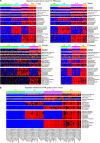Proliferation and tissue remodeling in cancer: the hallmarks revisited
- PMID: 23034332
- PMCID: PMC3481128
- DOI: 10.1038/cddis.2012.140
Proliferation and tissue remodeling in cancer: the hallmarks revisited
Abstract
Although cancers are highly heterogeneous at the genomic level, they can manifest common patterns of gene expression. Here, we use gene expression signatures to interrogate two major processes in cancer, proliferation and tissue remodeling. We demonstrate that proliferation and remodeling signatures are partially independent and result in four distinctive cancer subtypes. Cancers with the proliferation signature are characterized by signatures of p53 and PTEN inactivation and concomitant Myc activation. In contrast, remodeling correlates with RAS, HIF-1α and NFκB activation. From the metabolic point of view, proliferation is associated with upregulation of glycolysis and serine/glycine metabolism, whereas remodeling is characterized by a downregulation of oxidative phosphorylation. Notably, the proliferation signature correlates with poor outcome in lung, prostate, breast and brain cancer, whereas remodeling increases mortality rates in colorectal and ovarian cancer.
Figures



References
Publication types
MeSH terms
Substances
Grants and funding
LinkOut - more resources
Full Text Sources
Research Materials
Miscellaneous

